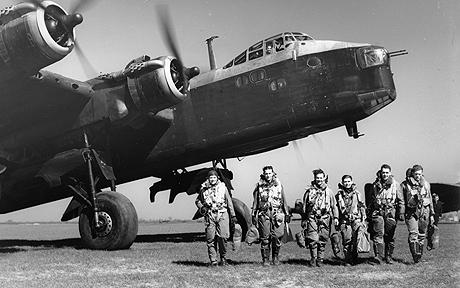An unknown unit left from Snaith at 1943-03-08 at 18:26
He flew with a Handley Page Halifax (type II, serial DT567, code MH-F).
Campaign report of the USAAF:
(Eighth Air Force): VIII Bomber Command Mission No. 41: 67 B-17's of the 1st Bombardment Wing and 16 B-24's of the 2d Bombardment Wing are dispatched against the marshalling yard at Rouen, France. Thirteen B-24's drop 39 tons of bombs on the target at 1402-1403 hours local; we claim 14 aircraft destroyed, 3 probably destroyed and 3 damaged; we lose 2 B-24's, 1 is damaged beyond repair and 3 others are damaged; casualties are 5 KIA, 3 WIA and 17 MIA. 54 B-17's hit the target at 1430 hours dropping 134.75 tons of bombs; they claim 14 enemy aircraft destroyed, 1 probably destroyed and 5 damaged; we lose 2 B-17's, 1 is damaged beyond repair and 9 others are damaged; casualties are 8 WIA and 20 MIA. The bomb run over Rouen is considerably disrupted by the well-executed attack of fighters which down 2 bombers including the lead aircraft. This action is preceded by an earlier wave of German fighters which occupy the fighter escort while the second wave attacks the bombers
Campaign report of the RAF:
7/8 March 1943
14 Wellingtons and 6 Halifaxes of No 4 Group minelaying in the Frisians, 2 OTU sorties. 1 Halifax and 1 Wellington of the minelaying force lost.
8 March 1943
16 Mosquitos to railway centres at Tergnier and Aulnoye in France and at Lingen in Germany. All targets were bombed; 1 Mosquito lost.
8/9 March 1943
335 aircraft - 170 Lancasters, 103 Halifaxes, 62 Stirlings - to Nuremberg. 8 aircraft - 4 Stirlings, 2 Halifaxes, 2 Lancasters - lost, 2.4 per cent of the force.
This distant raid had to be marked by a combination of H2S and visual means. The Pathfinders had no moon to help them and, although there was no cloud, they found that haze prevented accurate visual identification of the target area. The result was that both marking and bombing spread over more than 10 miles along the line of the attack, with more than half of the bombs falling outside the city boundaries. This result would be typical of raids carried out beyond the range of Oboe during this period.
Sergeant DR Spanton, a mid-upper gunner in a 7 Squadron Stirling, had a fortunate escape on this night. After his aircraft crossed the English coast on the return flight, Spanton realized that he was the only man still in the plane. The remainder of the crew, newly arrived on this Pathfinder squadron, had baled out earlier, possibly because of suspected fuel shortage, and the pilot left the plane flying on automatic pilot. Spanton had not heard the order. He parachuted safely over Kent and the empty Stirling later crashed into the Thames estuary. The remainder of the crew, presumably thinking they were parachuting over France, had actually come down in the sea and were all drowned. Sergeant Spanton went on to fly a further 12 operations but his plane was lost on the night of 24/25 June 1943 in a raid on Wuppertal and the presence of his name on the Runnymede Memorial probably indicates that he died in the sea on that occasion.
4 Mosquitos to the Ruhr, 16 Wellingtons minelaying in the Frisians. No losses.
With thanks to the RAF and USAAF.net!
This record can also be found on the maps of Back to Normandy with Google coordinates. You can find the maps by clicking on this link on this location.
There are several possibilities to investigate the flight records on Back to Normandy. All the flights are plotted on maps, sorted "day by day", "by squadron", "by type aircraft", "by year or month", "by location" and much more! Don't miss this!!!
If you have any information that you want to share, please add your comment at the bottom of this record. Or send your information to [email protected]. This information will be added to the record.
Your photos and your information are very welcome! The young do care and with your help we keep up the good work.



